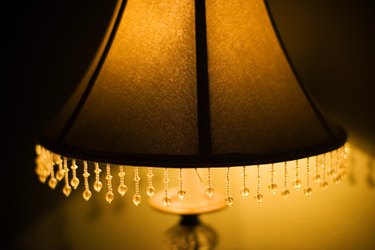Things You'll Need
Seam ripper
Tissue paper
Pencil
Tape measure
Scissors
Straight pins
Fabric - muslin (or natural fiber fabric)
Hand sewing needle
Thread

Relining the interior of a damaged lampshade involves hand sewing. The shade's lining gets hotter than the exterior because of the fabric's proximity to the light bulb. Because of the bulb's heat, use a natural fiber fabric such as muslin. Synthetic fabrics will melt when exposed to the bulb. Use a bulb no higher than 60-watts to ensure the lining doesn't overheat. Create a pattern, and then hand sew each panel to the interior frame.
Step 1
Place the shade on a table. Examine the interior top edge to determine if the lining is sewn to the frame or glued. If sewn, insert the seam ripper under a stitch, lifting upward, cutting the stitch. Continue around the top edge, until the lining top is loose. If the lining is glued, insert the ripper between the lining and the exterior covering. Wiggle the ripper to separate the adhesive from the frame. The frame's ribs and top/bottom have fabric wrapped around the metal. Gently pull the lining from the adhesive. If you can't separate the adhesive, cut the lining away. Repeat for the lining's bottom edge.
Video of the Day
Step 2
Look at the lining to determine how it is applied to the ribs. The lining may not be attached to the ribs. It may be sewn or glued in one or more pieces. Remove the lining from the ribs with the seam ripper if sewn, or separate from the adhesive if glued.
Step 3
Create a pattern based on one panel of the frame. Lay tissue paper over one panel. Use a pencil to rub the paper over the left/right rib and the top/bottom creating a rubbing of the panel's shape.
Step 4
Lay the pattern on the table. Use a ruler to measure ¼ -inch longer and wider than the rubbing lines. This is the seam allowance for turning under the raw fabric edges when sewing. Cut out the pattern.
Step 5
Pin the pattern to the fabric. Count the number of shade panels. Cut one fabric piece for each shade panel.
Step 6
Position a fabric panel with the fabric's right side facing "the bulb". The fabric's underside won't be visible. Fold the top edge of the fabric panel under ¼-inch. Use straight pins to secure the folded edge to the frame's top edge through the fabric on the frame (this could be rib wrapping or the interior casing from the exterior cover).
Step 7
Pull the fabric panel's bottom edge taut to the frame's bottom. Fold the edge under ¼-inch. Use straight pins to secure to the frame's bottom.
Step 8
Fold the left and right edge of the panel fabric under ¼-inch. Pin the edges to the left and right rib.
Step 9
Thread a needle with thread matching the lining. Craft Stylish Magazine suggests using a whipstitch or blindstitch. An overcast stitch can also be used. Begin at the top of the left rib: sew across the panel's top, along the right rib, across the frame's bottom, and up along the left rib. According to "Craft Stylish Magazine", aim for neat stitches.
Step 10
Rotate the frame to the right. Position another fabric panel over the frame panel adjacent to the previously attached fabric panel. Fold the top edge under ¼-inch. Sew it to the frame. Repeat Steps 7-9. Repeat Steps 6-10 until all fabric panels have been sewn to the frame.
Video of the Day